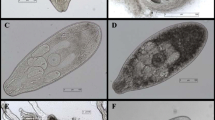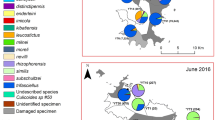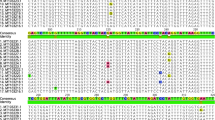Abstract
The trematode Alaria alata has a complex life cycle in which carnivore mammals may become infected by feeding on mesocercariae-infected, second intermediate hosts or paratenic hosts. Afterwards, young flukes migrate through various organs of the definitive host, including the diaphragm and the lungs, before reaching the small intestine. The aim of the present study was to establish the prevalence and infection intensity of A. alata in carnivore mammals, the host age and related occurrence of different A. alata development stages in particular animals in Latvia. Overall, samples from 992 animals (539 red foxes, 411 raccoon dogs and 42 grey wolves) were examined using sedimentation and counting techniques to observe the presence of A. alata metacercariae and adult trematodes in each particular host. The present study, based on data collected over five hunting seasons (2010/2011–2014/2015), is a comprehensive study on the circulation of A. alata in wild canids in Latvia. A. alata was present in all species examined and the overall prevalence reached 86.2%. A significant positive correlation was observed between the burden of A. alata metacercariae and adult trematodes in raccoon dogs (rs = 0.27, p = 0.001) and red foxes (rs = 0.17, p = 0.0002). A significantly higher (p = 0.003) A. alata metacercariae mean intensity was observed in juvenile raccoon dogs compared to the one observed in adult raccoon dogs and red foxes from both age groups. The presence of both A. alata development stages in a particular animal concurrently and at different intensity levels may indicate primary infection and re-cured infection of the host.



Similar content being viewed by others
References
Al-Sabi MNS, Chriél M, Jensen TH, Enemark HL (2013) Endoparasites of the raccoon dog (Nyctereutes procyonoides) and the red fox (Vulpes vulpes) in Denmark 2009–2012—a comparative study. Int J Parasitol Parasites Wildl 2:144–151
Altizer S, Nunn CL, Thrall PH, Gittleman JL, Antonovics J, Cunningham AA, Dobson AP, Ezenwa V, Jones KE, Pedersen AB, Poss M, Pulliam JRC (2003) Social organization and parasite risk in mammals: integrating theory and empirical studies. Annu Rev Ecol Evol Syst 34:517–547
Anderson RM, May RM (1985) Age-related changes in the rate of disease transmission: implications for the design of vaccination programmes. J Hyg 94:365–436
Bagrade G, Kirjušina M, Vismanis K, Ozoliņš J (2009) Helminth parasites of the wolf Canis lupus from Latvia. J Helminthol 83:63–68
Baltrūnaitė L (2002) Diet composition of the red fox (Vulpes vulpes L.), pine marten (Martes martes L.) and raccoon dog (Nyctereutes procyonoides Gray) in clay plain landscape, Lithuania. Acta Zoologica Lituanica 12:362–368
Borgsteede FHM (1984) Helminth parasites of wild foxes (Vulpes vulpes L.) in the Netherlands. Z Parasitenkd 70:281–285
Bruneniece I, Klavins M (2011) Normative principles for adaptation to climate change policy design and governance. In: Leal FW (ed) The economic. Social and Political Elements of Climate Change. Climate Change Management. Springer, Berlin, Heidelberg, pp 41–65
Bružinskaite-Schmidhalter R, Šarkūnas M, Malakauskas A, Mathis A, Torgerson PR, Deplazes P (2012) Helminths of red foxes (Vulpes vulpes) and raccoon dogs (Nyctereutes procyonides) in Lithuania. Parasitology 139:120–127
Bush AO, Lafferty KD, Lotz JM, Shostak AW (1997) Parasitology meets ecology on its own terms: Margolis et al., revisited. J. Parasitol 83:575–583
Chase JM (2003) Strong and weak trophic cascades along a productivity gradient. Oikos 101:187–195
Craig HL, Craig PS (2005) Helminth parasites of wolves (Canis lupus): a species list and analysis of published prevalence studies in Nearctic and Palearctic populations. J Helminthol 79:95–103
Criado-Fernelio A, Gutierrez-Garcia L, Rodriguez-Caabeiro F, Reus-Garcia E, Roldan-Soriano MA, Diaz-Sanchez MA (2000) A parasitological survey of wild red foxes (Vulpes vulpes) from the province of Guadalajara, Spain. Vet Parasitol 92:245–251
Dorny P, Praet N, Dackers N, Gabriel S (2009) Emerging food-borne parasites. Vet Parasitol 162:196–206
Drygala F, Stier N, Zoller H, Boegelsack K, Mix HM, Roth M (2008) Habitat use of the raccoon dog (Nyctereutes procyonoides) in North-Eastern Germany. Mamm Biol 73:371–378
Drygala F, Werener U, Zoller H (2013) Diet composition of the invasive raccoon dog (Nyctereutes procyonides) and the native red fox (Vulpes vulpes) in north-East Germany. Hystrix It J Mamm 24:190–194
Duscher G, Prosl H, Joachim A (2005) Scraping or shaking—a comparison of methods for the quantitative determination of Echinococcus multilocularis in fox intestines. Parasitol Res 95:40–42
Duscher GG, Leschnik M, Fuehrer HP, Joachim A (2015) Wildlife reservoirs for vector-borne canine, feline and zoonotic infections in Austria. Int J Parasitol Parasites Wildl 4:88–96
Dyer NW, Greve JH, Bartholomay B (1997) Alaria arisaemoides in a black Labrador retriever pup. J Vet Diagn Investig 9:203–205
Eira C, Viganda J, Torres J, Miquel J (2006) The helminth community of the red fox, Vulpes vulpes, in Dunas de Mira (Portugal) and its effect on host condition. Wildl Biol Pract 2:26–36
Esīte Z, Bagrade G, Deksne G (2013) Alaria alata in mammals of Latvia. – Trop. Med. Int. Health 18:–226
Galaktionov KV, Dobrovolskij AA (2003) The biology and evolution of trematodes. Chapter 4: Specific traits of populations formed by trematodes. Springer Science+Business Media Dordrecht, Netherlands
Gordon CA, McManus AP, Jones MK, Gray DJ, Gobert GG (2016) Advances in Parasitology. Chapter Six: The Increase of Exotic Zoonotic Helminth Infections The Impact of Urbanization, Climate Change and Globalization, Elsevier, pp 311–397
Górski P, Zalewski A, Łakomy M (2006) Parasites of carnivorous mammals in Białowieża primeval Forest. Wiad Parazytol 52:49–53
Ivanov VM, Semenova NN (2000) Parasitological consequences of animal introduction. Russ J Ecol 31:281–283
Johnson PTJ, Chase JM, Dosch KL, Hartson RB, Gross JA, Larson DJ, Sutherland DR, Carpenter SR (2007) Aquatic eutrophication promotes pathogenic infection in amphibians. Proc Natl Acad Sci 104:15781–15786
Kidawa D, Kowalczyk R (2011) The affects of sex, age, season and habitat on diet of the red fox Vulpes vulpes in northeastern Poland. Acta Theriol 56:209–218
Laurimaa L, Süld K, Davison J, Moks E, Valdmann H, Saarma U (2016) Alien species and their zoonotic parasites in native and introduced ranges: the raccoon dog example. Vet Parasitol 219:24–33
Lempp C, Jungwirth N, Grilo ML, Reckendorf A, Ulrich A, van Neer A, Bodewes R, Pfankuche VM, Bauer C, Osterhaus ADME, Baumgärtner W, Siebert U (2017) Pathological findings in the red fox (Vulpes vulpes), stone marten (Martes foina) and raccoon dog (Nyctereutes procyonoides), with special emphasis on infectious and zoonotic agents in northern Germany. PLoS One 12(4):e0175469
Loos-Frank B, Zeyhle E (1982) The intestinal helminths of the red fox and some other carnivores in Southwest Germany. Zeitschrift Fur Parasitenkunde 67:99–113 (in German)
Mehlhorn H (ed) (2008) Encyclopedia of parasitology. Third edition. Springer, Heidelberg, New York
Möhl K, Große K, Hamedy A, Wüste T, Kabelitz P, Lücker E (2009) Biology of Alaria spp. and human exposition risk to Alaria mesocercariae-a review. Parasitol Res 105:1–15
Moks E, Jõgisalu I, Saama U, Talvik H, Järvis T, Valdman H (2006) Helminthologic survey of the wolf (Canis lupus) in Estonia, with an emphasis on Echinococcus granulosus. J Wildl Dis 42:359–365
Moks E, Laurimaa L, Süld K, Soe E, Valdmann H, Saarma U (2014) Parasites of raccoon dog (Nyctereutes procyonoides) in Estonia. Daugavpils University academic press “Saule”. Daugavpils, Latvia, p 87
Olsen OW (1974) Animal parasites. Their life cycles and ecology. University Park Press, New York, pp 237–240
Otranto D, Cantacessi C, Dantas-Torres F, Brianti E, Pfeffer M, Genchi C, Guberti V, Capelli G, Deplazes P (2015) The role of wild canids and felids in spreading parasites to dogs and cats in Europe. Part II: helminths and arthropods. Vet Parasitol 213:24–37
Ozoliņa Z, Deksne G (2017) Effectiveness of two methods for mesocercariae of Alaria alata detection in wild boars (Sus scrofa). Environmental and Experimental Biology 15:25–28
Ozoliņš J, Pilāts V (1995) Distribution and status of small and medium-sized carnivores in Latvia. Ann Zool Fennici 32:21–29
Ozoliņš J, Žunna A, Ornicāns A, Done G, Stepanova A, Pilāte D, Šuba J, Lūkins M, Howlett SJ, Bagrade G (2017) Action plan for Grey wolf Canis lupus conservation and management. LSFRI Silava, Salaspils
Patrelle C, Portier J, Jouet D, Delorme D, Ferté H (2015) Prevalence and intensity of Alaria alata (Goeze, 1792) in water frogs and brown frogs in natural conditions. Parasitol Res 114:4405–4412
Paulsen P, Ehebruster J, Irschik I, Lücker E, Riehn K, Winkelmayer R, Smulders FJM (2012) Findings of Alaria alata mesocercariae in wild boars (Sus scrofa) in eastern Austria. Eur J Wildl Res 58:991–995
Pilot M, Jędrzejewski W, Sidorovich VE, Meier-Augenstein W, Hoelzel AR (2012) Dietary differentiation and the evolution of population genetic structure in a highly mobile carnivore. PLoS One 7:e39341
Portier J, Vallée I, Lacour AL, Martin-Schaller R, Ferté H, Durand B (2014) Increasing circulation of Alaria alata mesocercaria in wild boar populations of the Rhine valley, France, 2007-2011. Vet Parasitol 199:153–159
Poulin R (1996) Sexual inequalities in helminth infections: a cost of being male? Am Nat 147:287–295
Roepstorff A, Nansen P (1998) Epidemiology, diagnosis and control of helminth parasites of swine: FAO Animal Health Manual NO 3.Rome
Ruas JL, Müller G, Farias NA, Gallina T, Lucas AS, Pappen FG, Sinkoc AL, Brum JG (2008) Helminths of pampas fox, Pseudalopex gymnocercus (Fischer, 1814) and crab-eating fox, Cerdocyon thous (Linnaeus, 1766) in the south of the state of Rio Grande do Sul, Brazil. Rev Bras Parasitol Vet 17:87–92
Saeed I, Maddox-Hyttel C, Monrad J, Kapel CM (2006) Helminths of red foxes (Vulpes vulpes) in Denmark. Vet Parasitol 139:168–179
Schuster R, Schierhorn K, Heidecke D, Ansorge H (1993) Untersuchungen zur Endoparasitenfauna des Marderhundes Nyctereutes procynoides (Gray, 1834) in Ostdeutschland. Beitr Jagd Wildforschung 18:83–87 (in German)
Segovia JM, Torres J, Miquel J, Llaneza L, Feliu C (2001) Helminths in the wolf, Canis lupus, from North-Western Spain. J Helminthol 75:183–192
Segovia JM, Guerrero R, Torres J, Miquel J, Feliu C (2003) Ecological analyses of the intestinal helminth communities of the wolf, Canis lupus, in Spain. Folia Parasitol (Praha) 50:231–236
Shimalov VV, Shimalov VT (2000) Helminth fauna of the wolf (Canis lupus Linnaeus, 1758) in Belorussian Polesie. Parasitol Res 86:163–164
Shimalov VV, Shimalov VT (2003) Helminth fauna of the red fox (Vulpes vulpes Linnaeus, 1758) in southern Belarus. Parasitol Res 89:77–78
Shoop WL (1994) Vertical transmission in the Trematoda. J Helminthol Soc Washingt 61:153–161
Sidorovich VE, Tikhomirova LL, Jedrzejewska B (2003) Wolf Canis lupus numbers, diet and damage to livestock in relation to hunting and ungulate abundance in northeastern Belarus during 1990-2000. Wildlife Biol 9:103–111
State Monitoring plan of animal infectious diseases (2014) Food and veterinary service. Riga: ministry of agriculture
Süld K, Valdmann H, Laurimaa L, Soe E, Davison J, Saarma U (2014) An invasive vector of zoonotic diseases sustained by anthropogenic resources: the raccoon dog in northern Europe. PLoS One 9:e96358
Sutor A, Kauhala K, Ansorge A (2010) Diet of the raccoon dog Nyctereutes procyonides—a canid with an opportunistic foraging strategy. Acta Theriol (Warsz) 55:165–176
Szafrańska E, Wasielewski O, Bereszyński A (2010) A faecal analysis of helminth infections in wild and captive wolves, Canis lupus L., in Poland. J Helminthol 84:415–419
Tauriņš E (1982) Latvijas zīdītājdzīvnieki. Zvaigzne, Rīga 256 pp [in Latvian]
Timm U, Pilāts V, Balčiauskas L (1998) Mammals of the East Baltic. Proc Latvian Acad Sci Section B. Vol. 52 No. 1/2 (594/595): 1–9
Umhang G, Woronoff-Rhen N, Combes B, Boué F (2011) Segmental sedimentation and counting technique (SSCT): an adaptable method for qualitative diagnosis of Echinococus multilocularis in fox intestines. Exp Parasitol 128:57–60
Urtāns AV (ed) (2017) protected habitat conservation guidelines for Latvia. Volume 2: rivers and lakes. Nature conservation agency, Sigulda [in Latvian]
Vanags J (ed.) (2010) Hunting. Knowledge and truth. 978–9984–39-933-1 [in Latvian]
Wasiluk A (2013) Alaria alata infection - threatening yet rarely detected trematodiasis. J Lab Diagn 49:33–37
Wilson K, Bjørnstad ON, Dobson AP, Merler S, Poglayen G, Randolph SE, Read AF, Skorping A (2002) Heterogeneities in macroparasite infections : patterns and processes. In: Hudson PJ, Rizzoli A, Grenfell BT, Heesterbeek JAP, Dobson AP (eds) The ecology of wildlife diseases. Oxford University Press, Oxford, pp 6–44
Woolhouse MEJ (1998) Patterns in parasite epidemiology: the peak shift. Parasitol Today 14:428–434
Žunna A, Ozoliņš J, Bagrade G, Done G, Howlett S, Ornicāns A (2017) Feeding habitats of wolf (Canis lupus) in Latvia in relation to changes in prey abundance. 75th conference of the University of Latvia (3rd Febryary, 2017), www.lu.lv/konference/programma/?session=334
Acknowledgements
We would like to thank the staff of the Institute for Food Safety, Animal Health and Environment “BIOR”, the Latvian State Forest Research Institute “SILAVA” and the hunters, for their cooperation and positive attitude towards studying sylvatic carnivores. The authors would also like to thank the State Forest Service for providing information and estimates on the population size of carnivorous mammals. We are also grateful to Sabīne Birzgale of the JSC Latvia’s State Forest GEO service for drawing up various maps of Latvia.
Author information
Authors and Affiliations
Corresponding author
Ethics declarations
Conflict of interest
The authors declare that they have no conflict of interest.
Additional information
Section Editor: Domenico Otranto
Rights and permissions
About this article
Cite this article
Ozoliņa, Z., Bagrade, G. & Deksne, G. The host age related occurrence of Alaria alata in wild canids in Latvia. Parasitol Res 117, 3743–3751 (2018). https://doi.org/10.1007/s00436-018-6074-5
Received:
Accepted:
Published:
Issue Date:
DOI: https://doi.org/10.1007/s00436-018-6074-5




